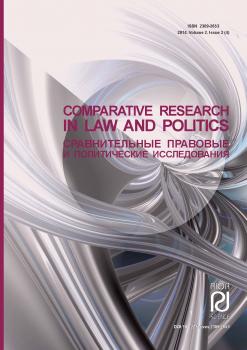Penza, Russian Federation
The article deals with the evolution of USA Legal System starting from the 1787 Constitution till the end of the 19th century. Taking corporate, land regulation, criminal law as examples the author considers participation of federal and state powers in solving actual legal problems. It is demonstrated that in spite of broad legal rights of states from the very beginning they were not able to decide themselves burning issues of social and economic life without interference of Federal Government. And Federal Government was clever enough to build up a strong federal court system in the early years of the Republic. This system not only furthered some kind of uniformity of law under grass roots federalism but safequarded American federalism itself. Thanks to broad interpretative powers of US Supreme Court which decided what was Constitutional or non-Constitutional in state and federal legislation American civilization not only has preserved itself from dangers of separatism but achieved great paces of development.
evolution of state and federal law in theUSA, history of corporate law, history of anti-monopolylegislation, federal land law in the 19th century,growth of federal criminal law, expansion of federal judicialsystem.
USA is a unique state which combines favourable climate, rich resources and personal achievements of energetic settlers. In contrast with more severe in climate Canada and far much distant Australia it has won independence in the late 18th century — on the eve of Industrial Era. It attracted during 1800–1914 nearly 60% of 65 million migrants from Europe. ‘The United States received more than the rest of the New World, and probably the entire world, combined… Its absorptive capacity was thus exceptional in sheer numbers’ [1]. Optimal distance from the Old World (enough not to be involved in constant wars and permissive for intense communications with Europe) led to profitable external trade and multinational migrations to provide for necessary work-force. Multiplicity of legal status of North American colonies widely dispersed along Atlantic Coast which are subdivided into royal (state), private and corporate (collective) ones has laid the foundation of the future territorial pluralism of the USA. Real economic, social, political and cultural differences between New England, Middle Atlantic and Southern colonies strengthened this pluralism. Colonies were established one by one during rather long time (more than 150 years). ‘throughout the colonial period, the colonists borrowed as much English law as they wanted to take or were forced to take. Their appetite was determined by requirements of the moment, by ignorance or knowledge of what was happening abroad, and by general obstinacy. Mapping out how far colonial law fit English law is almost a hopeless job. Legal cultures differed in different colonies. New England deviated from standart English law more than the Southern colonies did’ [2, p. 20].
1. Nugent W. Crossings. The Great Transatlantic Migrations, 1870-1914. Bloomington, Indianapolis, 1992. P. 30.
2. Friedman L.A. History of American Law. 2nd Edition. N.Y., 1985. P. 20.
3. Pound R. The Development of Constitutional Guarantees of Liberty. New Haven, L., 1957. P. 82.
4. Cornelius J. Constitutional Making in Illinois 1818-1970. Urban, Chicago, L.,1972. P. 11.
5. See: Boncevich N.N. Severnaya Karolina v period Rekonstrukcii: nekotorye aspekty konstitucionnoy istorii shtata // Amerikanskiy ezhegodnik-1999. M., 2001. S. 109.
6. Kreder A.A. Amerikanskaya predprinimatel'skaya korporaciya: pervoe stoletie istorii // Amerikanskiy ezhegodnik-1993. M.,1994. C. 56.
7. Atack J., Passell P.A New Economic View of American History from Colonial Times to 1940. N.Y., L., 1994.
8. Schlesinger R.R. The Power that Governs. The Evolution of Judicial Activism in a Midwestern State, 1840-1890. N.Y. and L., 1990. P. 4.
9. Chadler A.D., jr., Tedlow R.S. The Coming of Managerial Capitalism. A Casebook on the History of American Economic Institutions. Homewood, Ill., 1985. P. 554.
10. Robbins R.M. Our Landed Heritage. The Public Domain. 1776-1936. Princeton, 1942. P. 17-18.
11. Salomatin A.Yu. Agrarnoe zakonodatel'stvo i stanovlenie amerikanskogo fermerstva (konec XVIII-XIX vv.) // Pravo i politika. 2002. № 3.
12. Shannon F.A. The Farmers Last Frontier: Agriculture. 1860-1897. N.Y., 1845. P. 51.
13. Gates P.W. An Overview of American Land Policy // American Law and the Constitutional Order. Historical Perspectives / Ed. by L. Friedman and H.N. Scheiber. Cambridge and L., 1988. P. 125.
14. Nelson W.E. Americanization of the Common Law. The Impact of Legal Change of Massachusetts Society, 1760-1830. Cambridge, L., 1975. P. 39.
15. Smith P. The Nation Comes of Age. N.Y., L.,1981. P. 746.
16. Caughey J.W. Their majesties the Mob. Chicago,1960. P. 14.
17. Conboy M. Federal Criminal Law // Law. A Century of Progress. 1835-1935. Vol.1. N.Y., 1937. P. 302.
18. Basic Readings in US Democravy / Ed. by M.I. Uropsky. Wash., 1994. P. 49.
19. The Oxford Companion to American Law / Ed. by K.L. Hall. Oxford, 2002. P. 771.
20. Salomatin A.Yu. Verhovnyy Sud SShA. Sudebnaya pravovaya politika ot Dzh. Dzheya do Dzh. Robertsa. M., 2013. S. 136.
21. Collier C. Why the First Law School in the United States was Established in Connecticut // International Journal of Legal Information. Vol. 31. № 2. Summer 2003. P. 208.
22. Aumann F.R. The Changing American Legal System: Some Selected Legal Phases. Columbus. Oh., 1940. P. 79.






